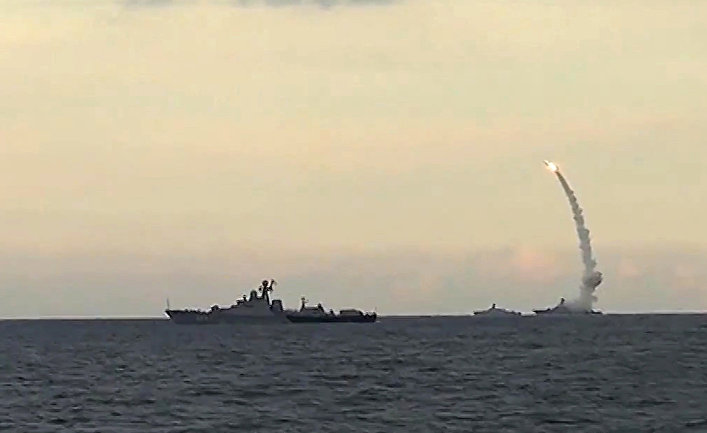
Since the beginning of 1990-x years the United States has launched hundreds of cruise missiles “Tomahawk” with their ships and submarines at targets in the middle East, North Africa, former Yugoslavia and Afghanistan. “The Tomahawk” flying at a speed of nearly 900 kilometres per hour, that is as fast as an airliner, capable of hitting targets at a distance of over a thousand kilometers, making this missile was let expensive but popular form of weapons, allowing the use of American firepower without sacrificing its troops.
However, the United States and Britain, which also has “Tomahawk”, is not the only country capable of waging war using cruise missiles, long-range.
On 7 October the Russian patrol ship “Dagestan” project 11661 and three small missile ships of “Desperado” made a series of volleys of 26 missiles “Caliber” from the Caspian sea through its vertical launch system. Nine rockets fast-flying a thousand miles over Iranian and Iraqi territory, and then struck 11 targets in Syria, killing ISIS fighters (banned in Russia as a terrorist organization — approx. TRANS.) and rebels from the Free Syrian army. Though Pentagon sources claim that four missiles went off course and crashed in Iran, causing the loss of Iran’s cow population, it still was a vivid demonstration of Russian missile power in combat, which have very few countries.
After another launch 18 missiles “Caliber” produced by the operational group of ships headed by the flagship “Dagestan” in November, 9 December 2015 diesel submarine “Rostov-on-don” project 636.3 “Varshavyanka” made their own rockets at targets in Syria that has been fighting debut for the contemporary submarine forces of Russia. In 2016, the Russian patrol ships fired from the Mediterranean area at least three sub-launch cruise missiles on Aleppo and Idlib.
At the time of the first impact in 2015 in Syria has acted Russian combat aircraft that could launch air strikes on these targets with much less cost. However, demonstrating the capabilities of its Navy for strikes at long range, only showed their technical achievements, but also just advertised capabilities of the missile “Calibre” foreign buyers can also choose the version of the missile complex short range Club.
In the rocket family “Caliber” there are over a dozen different options, different launchers, with range, character of targeted goals and speed. The length of these missiles from six to nine metres and each is equipped with a warhead capacity of 450 kg or a nuclear warhead. Anti-ship variants 3M54T and 3М54К (SS-N-27 Sizzler NATO classification) launched from ships or submarines, respectively, and have less range estimated component from 440 to 650 kilometers. These missiles fly at a low altitude over the sea surface invisible to enemy radar. Version of the missile, launched from the ship, has the advantage of thrust vector control by turning the nozzle, and the rocket “Caliber” with active radar homing also designed to perform evasive maneuvers instead of convergence with the target in a straight line. Flying a short distance to the enemy ship, this missile is accelerating from a cruising speed of M=0.8 to M=3 and is decreasing, continuing the flight at an altitude of just 4.6 meters. Because of this ship missile systems are extremely difficult to identify and defeat the Russian rocket.
Options to destroy ground targets, such 3M14T and 3M14K (SS-N-30A in NATO classification) may not accelerate to a speed of M=3 in the terminal phase of flight. But these rockets inertial guidance launch range is from 1 600 to 2 400 kilometers. The third class of missiles “Caliber” — 91РТ and 91РЭ — designed to destroy enemy submarines and has a range of around 50 km.
Currently missiles “Caliber” armed Russian submarines of the project “Halibut” and “Varshavyanka” as well as more modern types, including “Shark”, “Lada” and “Ash”. “Caliber” equip patrol ships, but only a large class, although the gradual process of modernization. The Russian patrol ship “Cheetah” has only eight missiles “Caliber”, but the destroyer URO they will have dozens.
On the other hand, Russia has demonstrated its ability to apply this powerful long-range weapons aboard small ships, which are dispersed. The idea is that in an era of increasingly lethal weapons long range to distribute firepower on small moving platforms, and not to create one large, expensive and vulnerable group. Meanwhile, the American program for optimal dispersal of combat power, using ships of the coastal zone is facing serious difficulties, and besides, armed ships of the coastal zone of the class frigate no such powerful rockets as “Caliber”, which are placed even on small patrol ships.
Export version of the Club has a smaller range that is from 225 to 300 kilometers in accordance with the regime of control over missile technologies, which prohibits the export of cruise missiles with a range over 300 kilometers. Complexes Slub installed on submarines of the project “warszawianka” in the Navy of China, India, Algeria, Vietnam, and possibly in Iran, and on Indian frigates type “Talwar”. China has also developed cruise missiles, long-range YJ-18, which likely is a partial copy of the Slub.
Further, developing an aviation version of the Club missile for launch from naval patrol aircraft Tu-142, which are in service in the Russian air force and India. Russia has also demonstrated anti-ship version of land-based. It is noteworthy that these missiles can be hidden in nondescript shipping container. This version of the missile complex Club-K can carry civil freight trains, cargo ships and automobiles, which can detect and destroy these weapons from a distance is very difficult. But while the cases of combat use of such complexes has not been reported.
Although Russia still produces other types of sea-based cruise missiles “Caliber” will be a major shock long-range weapon of the Navy for many years. Missiles to destroy ground targets is theoretically inferior to American “Tomahawk” in their characteristics, and anti-ship missiles capable of supersonic speed in the terminal phase of flight can be even more effective. Although the number of ships of the Russian fleet gives the us the ability to place a winged long-range missiles on the ships of small displacement forces the American military often and seriously think about it.
Sebastian Robin has a master’s degree at Georgetown University in the field of conflict resolution. He worked as a University instructor in the peace Corps in China. He also dealt with issues of education, editorial work and problems of resettlement of refugees in France and the United States. Robin regularly publishes articles on security issues and military history on the website War is Boring.







